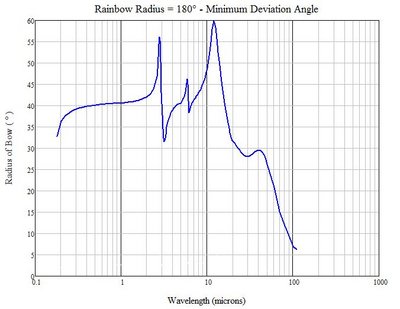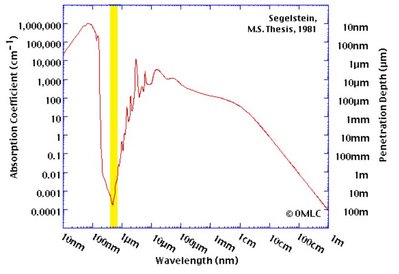geckzilla wrote:I meant a substance with the refractive qualities of a raindrop but without the absorptive qualities.
Looking only at the geometric analysis of
primary rainbows formed from spherical water drops (i.e. no scattering behavior) and assuming no absorption, the only allowed bows are 1 < n
R < 2, where n
R = index of refraction of water. The "Rainbow Angle" (RA) for a specific wavelength (
minimum deviation angle) is readily calculated. For a given wavelength, the radius of a rainbow arc = 180° - RA. Below I plotted the bow radius verses wavelength (0.18um to ~110um). Since n
R is not monotonic over this entire range, they would appear to be all over the place if you could see them. In the UV to Near IR range, n
R is monotonic so thus the longer wavelengths have larger radii. As n
R => 1 (vacuum), the bow radius => 90°, and as n
R => 2, the bow radius => 0°

- Arc Radii for Primary Rainbows
As pointed out, opacity is a main killer of bow visibility at both UV and IR wavelengths, but NIR bows have been
photographed. The graph below shows a fairly steep attenuation. By ~1.2um, water absorbs about 60% of the light compared to 0.7um (deep red) and even more when you add the black-body roll-off of the solar radiation. So the real wavelength range for seeing bows is quite narrow even with sensitive equipment.

- Absorption Coefficient (yellow band = visible range)
[quote="geckzilla"]I meant a substance with the refractive qualities of a raindrop but without the absorptive qualities.[/quote]
Looking only at the geometric analysis of [u]primary[/u] rainbows formed from spherical water drops (i.e. no scattering behavior) and assuming no absorption, the only allowed bows are 1 < n[sub]R[/sub] < 2, where n[sub]R[/sub] = index of refraction of water. The "Rainbow Angle" (RA) for a specific wavelength ([url=http://en.wikipedia.org/wiki/Minimum_deviation]minimum deviation angle[/url]) is readily calculated. For a given wavelength, the radius of a rainbow arc = 180° - RA. Below I plotted the bow radius verses wavelength (0.18um to ~110um). Since n[sub]R[/sub] is not monotonic over this entire range, they would appear to be all over the place if you could see them. In the UV to Near IR range, n[sub]R[/sub] is monotonic so thus the longer wavelengths have larger radii. As n[sub]R[/sub] => 1 (vacuum), the bow radius => 90°, and as n[sub]R[/sub] => 2, the bow radius => 0°
[attachment=0]Rainbow Arc Radius Plot.JPG[/attachment]
As pointed out, opacity is a main killer of bow visibility at both UV and IR wavelengths, but NIR bows have been [url=http://www.atoptics.co.uk/fz685.htm]photographed[/url]. The graph below shows a fairly steep attenuation. By ~1.2um, water absorbs about 60% of the light compared to 0.7um (deep red) and even more when you add the black-body roll-off of the solar radiation. So the real wavelength range for seeing bows is quite narrow even with sensitive equipment.
[attachment=1]Absorption Coefficient_Water.JPG[/attachment]